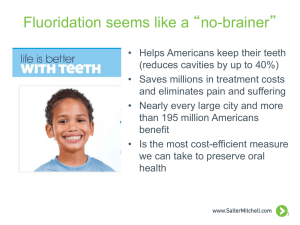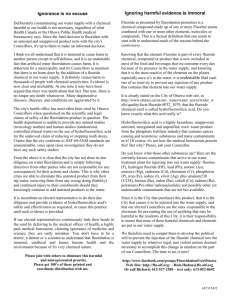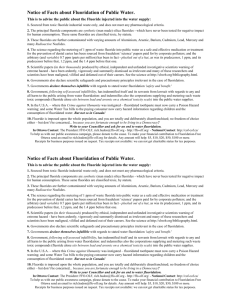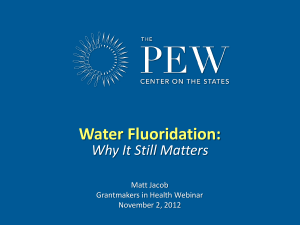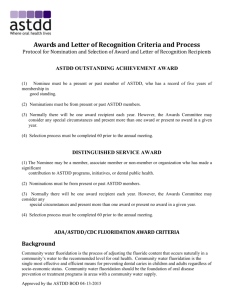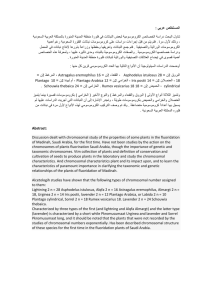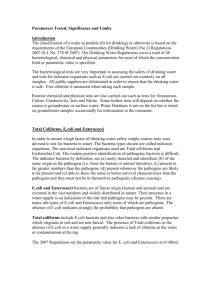Annual Report 2011-12 - Department of Health and Human Services
advertisement
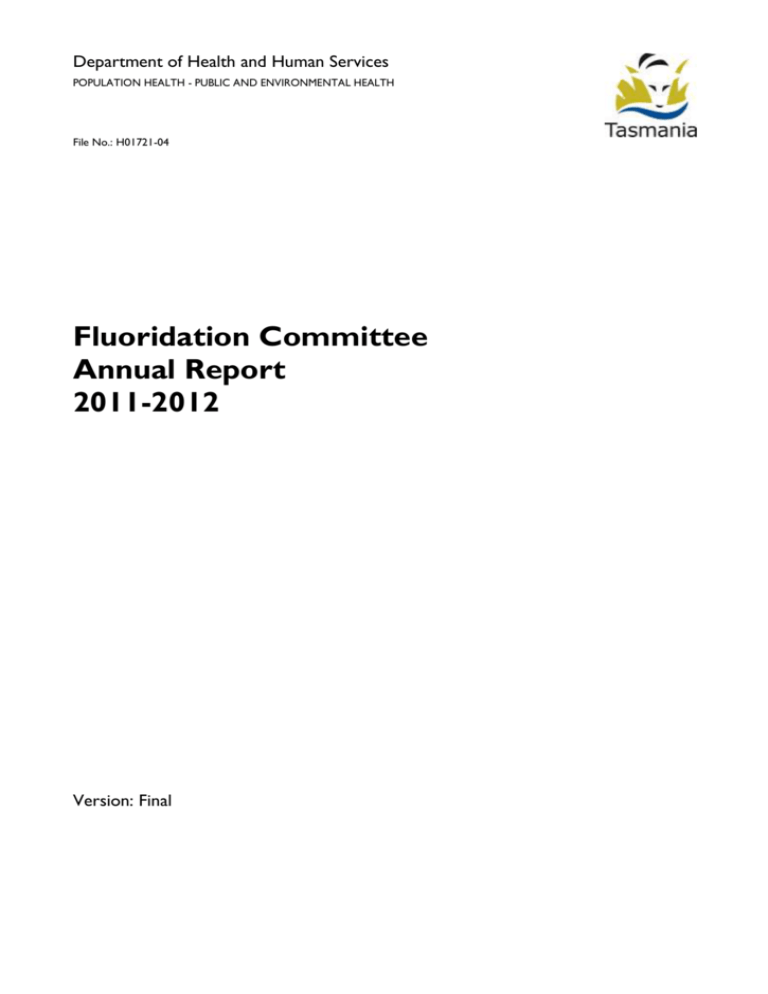
Department of Health and Human Services POPULATION HEALTH - PUBLIC AND ENVIRONMENTAL HEALTH File No.: H01721-04 Fluoridation Committee Annual Report 2011-2012 Version: Final Fluoridation Committee Annual Report: 2011-12 Contents 1. Introduction 1 2. The Fluoridation Committee 2 3. Achievements in 2011-2012 3 4. Fluoridation Plant Status and Performance 4 4.1. Fluoridation Plant Status 4 4.2. Fluoridation Plant Performance 4 4.3. Plant Reliability 9 5. Future Activities 10 Figures and Tables Figure 1: Compliance of Southern Water Fluoridation plants against the target operating range (0.8-1.2 mg/L) for 2011-12 6 Figure 2: Compliance of Cradle Mountain Water Fluoridation plants against the target operating range (0.81.2 mg/L) for 2011-12 7 Figure 3: Compliance of Ben Lomond Water Fluoridation plants against the target operating range (0.8-1.2 mg/L) for 2011-12 8 Table 1: Compliance of fluoridation plants – fluoride concentration and plant reliability 9 Fluoridation Committee Annual Report: 2011-12 1. Introduction This report was prepared in accordance with section 17(2) of the Fluoridation Act 1968 (the Act). Water fluoridation is the adjustment of fluoride in drinking water to a concentration that helps prevent dental decay. The National Health and Medical Research Council (NHMRC) affirms that water fluoridation remains the most socially equitable method of achieving community-wide exposure to the health benefits of fluoride. Adjusting fluoride levels to the NHMRC-recommended levels in public water supplies has proven a safe and effective measure in the prevention of dental health problems. Water fluoridation receives endorsement by more than 150 science and health organisations worldwide and fluoridation programs have the strong support of the NHMRC, the World Dental Federation, the International Association for Dental Research and the World Health Organisation The National Oral Health Plan 2004-2013 suggested that for each dollar invested in water fluoridation the savings in dental treatment costs range from $12 to $801. Comparable financial data are not available for Tasmania however in Victoria in the past 25 years, fluoridation is estimated to have saved the Community nearly $1 billion in avoided dental costs, lost productivity and saved leisure time2. Given the improvements in oral health and reductions in associated health costs, State and Territory governments intend to extend their fluoridation programs under the National Oral Health Plan 2004-2013. In Tasmania, 88% of the population receives fluoridated drinking water. In accordance with the National Oral Health Plan 2004-2013, public water supply systems servicing all communities above 1000 in population in Tasmania are fluoridated. The exceptions are Scamander (population of 1250), Fingal (1590) and Bicheno (1400). Fluoridation of Tasmanian public drinking water supply systems commenced in 1953 (in Beaconsfield), making Tasmania the earliest jurisdiction to do so. Under the Fluoridation Act 1968, the Minister for Health directs the water corporations (based on recommendations from the Fluoridation Committee) to fluoridate specific public water supplies in a prescribed manner. Included in this Ministerial Direction is the need to monitor the level of fluoride in drinking water on a daily basis. The Fluoridation Committee’s Annual Report 2011-12 is the third reporting period in which the water corporations are the owners and service providers of fluoridation assets and water fluoridation respectively. The role of the Department of Health and Human Services (DHHS) remains as the regulatory body with strategic oversight being provided by the Fluoridation Committee. 1 Australia’s National Oral Health Plan 2004-2013. Prepared by the National Advisory Committee on Oral Health (July 2004). SA Department of Health 2 Department of Human Service, Victoria (2002). Information about water fluoridation: fluoridation strengthens teeth throughout life. Page | 1 Fluoridation Committee Annual Report: 2011-12 2. The Fluoridation Committee The Fluoridation Committee consists of five members, each appointed by the Minister for Health. The Deputy Director of Public Health (as a delegate of the Director of Public Health) occupied the position of committee chair until May 2012. After the Deputy Director of Public Health left the Department, the role of chairperson was assumed by the State Manager of Environmental Health Services. The principal functions of the Fluoridation Committee are to act as an expert advisory committee to interested parties including the Minister, on matters relating to fluoridation of drinking water and to provide strategic oversight of fluoridation works in Tasmania and report on the performance and outcomes of the fluoridation plants throughout the state. For 2011-12 the Fluoridation Committee members were: Dr Chrissie Pickin, Deputy Director of Public Health, Department of Health and Human Services (resigned May 2012). Mr Stuart Heggie, State Manager of Environmental Health Services, Department of Health and Human Services (commenced May 2012). Mr Bill (Kai Chye) Ho, Manager Water and Sewerage, New South Wales Office of Water. Dr David Butler, Director Clinical Services, Oral Health Services, Department of Health and Human Services. Dr John O’Reilly Section Head – Inorganic Chemistry (Metals), Department of Primary Industries, Parks, Water and Environment. Dr Martin Bicevskis, retired registered medical practitioner. Mr Cameron Dalgleish, State Water Officer, Department of Health and Human Services also attends the meetings in an administrative capacity. Meetings of the Fluoridation Committee were held: 12 September 2011 28 March 2012 13 June 2012 Page | 2 Fluoridation Committee Annual Report: 2011-12 3. Achievements in 2011-2012 The following are the key achievements in the implementation of water fluoridation during 2011-12: Ongoing replacement and standardisation of fluoridation equipment across the sites to facilitate management and maintenance; Significant contractual arrangements put in place by the Regional Water Corporations to strengthen arrangements for the surety of supply of fluoridating agents; Ongoing development of contingency supply plans for the fluoridating agents; Review of the Fluoridation Strategic Plan by the Fluoridation Committee; Ongoing investigations in conjunction with the EPA into industries emitting particulate fluoride in air emissions. Commencement of review and update of the Tasmanian Code of Practice for the Fluoridation of Public Water Supplies. Improved level of fluoride added to the water from the Box Hill (National Park) Fluoridation Station which contributes to the greater Hobart are water supply. (Further improvement has occurred since the reporting period.) Page | 3 Fluoridation Committee Annual Report: 2011-12 4. Fluoridation Plant Status and Performance 4.1. Fluoridation Plant Status There were 39 operating fluoridation plants in Tasmania for the reporting period of 2011-12. These plants are designed to provide fluoridated drinking water to approximately 87 per cent of the Tasmanian population. This is a significant proportion as public drinking water supplies provide reticulated water to approximately 89 per cent of the population. This is the same number of operational fluoridation plants as reported during the 2010-11 reporting period. Twenty-one plants use sodium fluoride (NaF), which is a white material available as an odourless powder or in a crystalline form. Fluoridation is accomplished by dissolving the sodium fluoride in water. To minimise occupational health and safety issues, the Fluoridation Committee has approved the use of soluble bags made of Poly Vinyl Alcohol (PVA) for the addition of sodium fluoride to drinking water. Eighteen plants use Fluorosilicic acid (H2SiF6), commonly known as FSA. FSA has advantages with regard to dosing accuracy and economics and is in use in most of the large water treatment plants around the State. The use of automated dosing systems to add FSA to water significantly reduces occupational health and safety issues. FSA is an extremely corrosive and volatile liquid with a pH level of 1.2 that can lower the pH of drinking water if the water does not have sufficient buffering capacity to neutralise the effect of this acidic fluoridating agent. 4.2. Fluoridation Plant Performance Under the Fluoridation (Interim) Regulations 2009, the Regional Water Corporations must maintain and operate fluoridation plants to ensure compliance with the following performance specifications: the fluoridation concentration range required in the drinking water supply is 0.8 to 1.2 mg/L of fluoride the maximum level of fluoride allowed in the water is 1.5 mg/L. (This latter maximum level is based on the Australian Drinking Water Guideline health limit) Additionally under the Tasmanian Code of Practice for the Fluoridation of Public Water Supplies 2007-2010, the Regional Water Corporations must maintain and operate fluoridation plants to ensure compliance with the following performance specifications: meet a target over a calendar year, that greater than 90% of all routine fluoride samples (both treated and distributed) fall within the fluoride concentration operating range of 0.8 mg/L to 1.2 mg/L. All three Regional Water Corporations submitted monthly performance reports during 2011-12. There are two metrics for measuring compliance of a fluoridation plant based on the reported fluoride concentrations. Firstly all daily fluoride concentrations are averaged over the reporting period with the resultant average fluoride concentration being assessed as compliant if it falls within the operating target range of 0.8-1.2 mg/L. Table 1 shows that 33 of the 39 fluoridation plants that operated throughout 201112 maintained an average fluoride dose within the required fluoride concentration range of 0.8 mg/L to 1.2 mg/L. This compares with 36 of 39 compliant fluoridation plants in 2010-11 and 35 of 39 in 2009-10. The non-compliant fluoridation plants failed to add sufficient fluoride to achieve the optimum fluoride range in the water supply. Page | 4 Fluoridation Committee Annual Report: 2011-12 The drop in compliance noted in this reporting period is largely attributable to the Regional Water Corporations actively addressing the operational management of their fluoridation plants. Corrective action often involves a shutdown (or partial shutdown) of a fluoridation station for a period of time that then skews the statistical analysis of the figures. The following non-compliant plants were noted during the 2011-12 reporting period with their average fluoride concentration given: 1. National Park (Southern Water) = 0.78 mg/L; 2. Cutten Street, Queenstown (Cradle Mountain Water) = 0.27 mg/L; 3. Strahan (Cradle Mountain Water) = 0.77 mg/L; 4. Campbell Town (Ben Lomond Water) = 0.68 mg/L; 5. Distillery Creek (Ben Lomond Water) = 0.67 mg/L; 6. St Marys (Ben Lomond Water) = 0.72 mg/L. The second measure of compliance assesses the percentage of individual reported fluoride concentrations (on a daily basis) that fall within the operating target range of 0.8-1.2 mg/L. The Code of Practice sets 90% as the compliance standard for this assessment. Graphically the compliance of each of the Regional Water Corporations can be seen in Figure 1 for Southern Water, Figure 2 for Cradle Mountain Water and Figure 3 for Ben Lomond Water. It should be noted that the two different measures of compliance cannot be directly compared as it is possible to exhibit compliance with one measure and not the other. For example the Fern Tree fluoridation plant operated by Southern Water reported an average yearly fluoride concentration of 0.85mg/L and was thus assessed as being compliant. However, the reported concentrations were only within the target operating range for 57% of the reported figures. Page | 5 Fluoridation Committee Annual Report: 2011-12 SW Performance of Fluoridation Plants - Regulatory (2011-12) Compliance Compliance Target 100 Compliance (%) 80 60 40 20 49.8 0 Box Hill 94.3 98.9 Bryn Estyn Donnelleys Road 99.7 57.0 Dover Fern Tree 94.3 96.7 Huonville Kermandie 75.1 97.6 92.0 85.5 97.6 81.4 82.5 Merton Nicholl's Rivulet Oatlands Orford Rocky Creek Swansea Triabunna Fluoridation plant Figure 1: Compliance3 of Southern Water Fluoridation plants against the target operating range (0.8-1.2 mg/L) for 2011-12 3 Compliance is measured as the percentage of daily fluoride concentrations that fall within the operating target range of 0.8 – 1.2 mg/L Page | 6 Fluoridation Committee Annual Report: 2011-12 CMW Performance of Fluoridation Plants - Regulatory (2011-12) Compliance Compliance Target 100 Compliance (%) 80 60 40 20 0 100.0 90.9 100.0 9.3 100.0 84.9 82.9 Barrington Burnie Cam Cutten St Queenstown Forth Gawler 90.0 100.0 Howard St - Hurst St Smithton Rosebery Queenstown 86.8 95.5 100.0 87.6 Stirling Valley Rosebery Strahan Whitehills Zeehan Fluoridation Plant Figure 2: Compliance4 of Cradle Mountain Water Fluoridation plants against the target operating range (0.8-1.2 mg/L) for 2011-12 4 Compliance is measured as the percentage of daily fluoride concentrations that fall within the operating target range of 0.8 – 1.2 mg/L Page | 7 Fluoridation Committee Annual Report: 2011-12 BLW Performance of Fluoridation Plants - Regulatory (2011-12) Compliance Compliance Target 100.0 Compliance (%) 80.0 60.0 40.0 20.0 0.0 69.8 51.0 98.6 91.8 51.2 94.0 88.6 89.6 71.4 94.0 41.7 63.2 Bridport Campbeltown Chimney Saddle Deloraine Distilery Creek Longford Mt Leslie Reatta Rd Scottsdale St Helens St Marys Westbury Fluoridation Plant Figure 3: Compliance5 of Ben Lomond Water Fluoridation plants against the target operating range (0.8-1.2 mg/L) for 2011-12 5 Compliance is measured as the percentage of daily fluoride concentrations that fall within the operating target range of 0.8 – 1.2 mg/L Page | 8 Fluoridation Committee Annual Report: 2011-12 4.3. Plant Reliability Fluoridation plant reliability focuses on the level of failure/breakdown of the fluoridation plants. Historically the Fluoridation Committee has recommended a reliability level of 95%. This means that the fluoridation system is operational for 95% of the time. The most common causes for low reliability are ageing equipment and/or a major malfunction, which can result in the system being offline for a significant period of time. Fluoridation plants which were not operational for a period of time for the purpose of upgrades and to address non-dosing issues (e.g. OH&S requirements) are not included in this measure. The plant reliability metric was utilised up to April 2012. The Fluoridation Committee decided that this measure was no longer adding any new valuable information with respect to the reliability of the fluoridation plants. The metric was initially developed to examine the plant operation in the earlier days of management when noted problems with dosing equipment were being experienced. Error! Reference source not found.shows that during 2011-12, 29 of the 39 fluoridation plants had acceptable reliability, which is a decrease from the previous reporting period when 34 of the 39 fluoridation plants achieved 95% or higher reliability. During 2009-10, 35 of the 39 fluoridation plants achieved 95% or higher reliability. It appears that the main factor affecting the drop in plant reliability compliance is associated with the increased instances of Regional Water Corporations notifying of disruptions to fluoridation plants. It is also reflective of the corrective actions undertaken by the Regional Water Corporations to reinstate fluoridation dosing after identifying problems. The following non-compliant plants were noted during the 2011-126 reporting period with their plant reliability given: 1. National Park (Southern Water) = 30%; 2. Merton (Southern Water) = 93.9%; 3. Cutten Street, Queenstown (Cradle Mountain Water) = 66.7%; 4. Bridport (Ben Lomond Water) = 88.5%; 5. Distillery Creek (Ben Lomond Water) = 66.5%; 6. Reatta Rd (Ben Lomond Water) = 75.4%; 7. Scottsdale (Ben Lomond Water) = 86.3%; 8. St Helens (Ben Lomond Water) = 93%; 9. St Marys (Ben Lomond Water) = 69.7%; 10. Westbury (Ben Lomond Water) = 91.8%. Number of fluoridation plants Number of fluoridation plants that complied with the prescribed fluoride concentration range Number of fluoridation plants with a reliability of 95 per cent or greater7 Ben Lomond Water 12 9 5 CradleMountain Water 13 11 12 Southern Water 14 13 12 Total 39 33 29 Water supplier Table 1: Compliance of fluoridation plants – fluoride concentration and plant reliability 6 Only for the period 1 July 2011 to 31 March 2012. 7 Only for the period 1 July 2011 to 31 March 2012. Page | 9 Fluoridation Committee Annual Report: 2011-12 5. Future Activities The following issues and activities will be progressed in 2012-13: Commissioning of new Water Treatment Plant at Waratah (Cradle Mountain Water) including fluoridation of the supply; Commissioning of new Water Treatment Plant at Queenstown (Cradle Mountain Water) including fluoridation of the supply; plus decommissioning of the poorly performing Cutten Street fluoridation plant; Review, consultation and amendments to the Fluoridation (Interim) Regulations 2009; Finalisation and issuing of the Tasmanian Code of Practice for the Fluoridation of Public Drinking Water Supplies 2012-2015; Review the options to expand the provision of fluoridation of drinking water to numerous communities with populations greater than 500 which currently do not received a fluoridated water supply; Continued implementation of a three year strategic and implementation plan for the Fluoridation Committee; Development of a formal emergency plan for fluoride overdose incidents. Fluoridation of the Ross Water Supply (Ben Lomond Water) Page | 10

